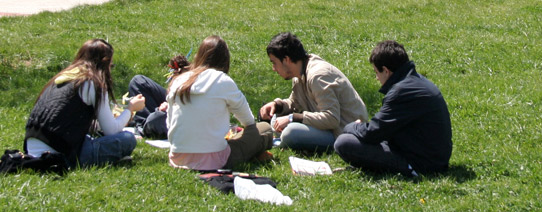|
|
 |

Tourist attractions in Cuenca
-
Catedral de la Inmaculada Concepción
Parque Calderón is the city's main plaza, dominated by the Catedral de la Inmaculada Concepción, the 'new cathedral,' whose giant sky-blue domes are visible mainly from the rear of the church. Inside, the marbled interior is rather stark. Construction began in 1885, and the cathedral was supposed to be much taller than it is - an error in design meant that the intended bell towers could not be supported by the building.
-
Centro Interamericano de Artes Populares
A block away from Museo Remigio Crespo Toral (283 3208; Calle Larga 7-27 near Borrero), on the stairs down to the river, the Centro Interamericano de Artes Populares displays changing exhibits of traditional indigenous costumes, handicrafts and artwork from around Latin America. It has an outstanding crafts store and promotes many of its featured artists and artisans by selling their work.
-
Church of El Carmen de la Asunción
Although its doors are rarely open to the public, the Church of El Carmen de la Asunción , founded in 1682, is one of Cuenca's prettiest sights, thanks to the colorful flower market (;daily) held on the small Plazoleta del Carmen out front.
-
Churches
Two blocks east of Plaza de San Sebastián stands the bare, 19th-century Church of San Cenáculo (cnr Bolívar & Montalvo). One block north of the church is Gran Colombia, the main handicraft and shopping street in Cuenca. The street's landmark building is the Church of Santo Domingo (cnr Gran Colombia & Padre Aguirre), which has some fine carved wooden doors and colonial paintings inside. Although it looks older, the church was built in the early 20th-century.
-
El Sagrario
This stark-white 'old cathedral' goes almost unnoticed thanks to the stunning Catedral de la Inmaculada Concepción nearby. Construction began in 1557, the year Cuenca was founded. In 1739, it was used as a triangulation point by La Condamine's expedition to measure the shape of the earth. More recently, it was renovated for the 1985 visit of Pope John Paul II to Ecuador.
-
La Escalinata
From Calle Larga, three attractive stone stairways lead down to Av 3 de Noviembre, which follows Río Tomebamba's north bank and makes for a pleasant walk. The largest staircase is the gorgeous La Escalinata.
-
Mirador de Turi
For a lovely view of Cuenca, take a taxi south of town along Avenida Solano to the stark white Church of Turi, perched high on a hillside in the southern suburb of Turi. The views are especially splendid on the occasional evenings (usually around holidays) when all of the churches' steeples and domes are lit throughout town. It's about 4km from the center.
-
Museo de las Conceptas
Cuenca's best religious museum is housed in the Convent of the Immaculate Conception, which was founded in 1599. The chapel of the infirmary has a display of crucifixes by the noted 19th-century local sculptor Gaspar Sangurima. Other parts of the building display a variety of religious paintings, carvings, statuettes, nativity scenes and other art.
-
Museo de las Culturas Aborígenes
Along Calle Larga, the Museo de las Culturas Aborígenes houses an outstanding collection of about 5000 archaeological pieces representing some 20 pre-Hispanic cultures of Ecuador and reaching as far back as 13,000 BC. The layout is very attractive, and there's a small gift shop and bookstore.
-
Museo Pumapungo
Considered Cuenca's most important museum, Museo Pumapungo merits a visit for the maze-like ethnographic exhibit alone. An entire floor of colorfully animated dioramas displays the traditional costumes of Ecuador's many cultures, including Afro-Ecuadorians from Esmeraldas province, the cowboy-like montubios of the western lowlands, several rainforest groups and all the major highland groups.
-
Museo Remigio Crespo Toral
Inside one of Calle Larga's historical buildings, the Museo Remigio Crespo Toral contains religious sculptures, colonial furniture, paintings and a fine selection of indigenous artifacts. It has been under restoration for some years and was scheduled to reopen in late 2006.
-
Old Cathedral
Almost unnoticed on the other side of the park across from the 'new cathedral' stands the stark-white old cathedral, which was renovated for the 1985 visit of Pope John Paul II to Ecuador. Construction of this building began in 1557, the year that Cuenca was founded. In 1739, it was used as a triangulation point by La Condamine's expedition to measure the shape of the earth.
-
Orquideario
If you've any interest in the world's most outrageous and beautiful plant species, you'll love the Universidad de Cuenca's Orquideario. With over 400 species of orchids, it's hailed as one of the country's best. Most plants are in flower between December and May - it's truly a sight to behold!
-
Parque Calderón
Parque Calderón is, without a doubt, Cuenca's showpiece plaza. The city's main plaza is dominated by the Catedral de la Inmaculada Concepción, the 'new cathedral,' whose giant sky-blue domes are visible mainly from the rear of the church.
-
Plaza de San Sebastián
Once the western edge of the historical center, the quiet Plaza de San Sebastián is anchored by the 17th-century Church of San Sebastian, one of the city's oldest churches. In 1739, Frenchman Juan Seniergues, a member of La Condamine's geodesic expedition, was violently murdered in this plaza during a fiesta, apparently because of an affair with a local woman. The south side of the plaza is flanked by the Museo de Arte Moderno.
-
Río Tomebamba & Calle Larga
The swift, rock-strewn Río Tomebamba is attractively lined with old colonial buildings that tower above the grassy riverside. The buildings themselves open onto the street of Calle Larga, which runs parallel to - and directly above - the river. From Calle Larga, three attractive stone stairways lead down to Avenida 3 de Noviembre, which follows the river's northern bank and makes for a pleasant walk. The largest staircase, at Hermano Miguel, is known as La Escalinata.
Go back to Learn Spanish in Cuenca
|
 |
|

